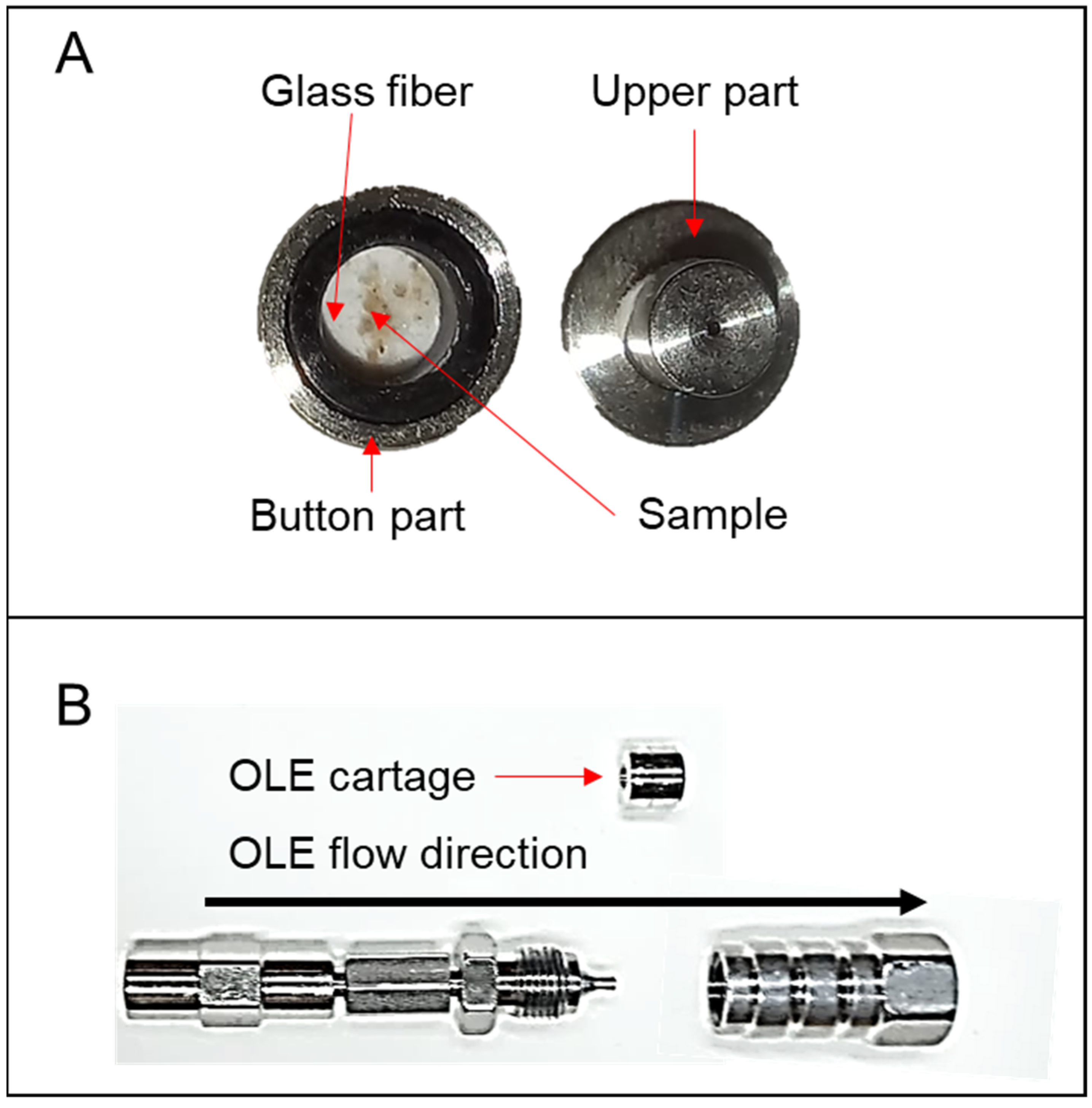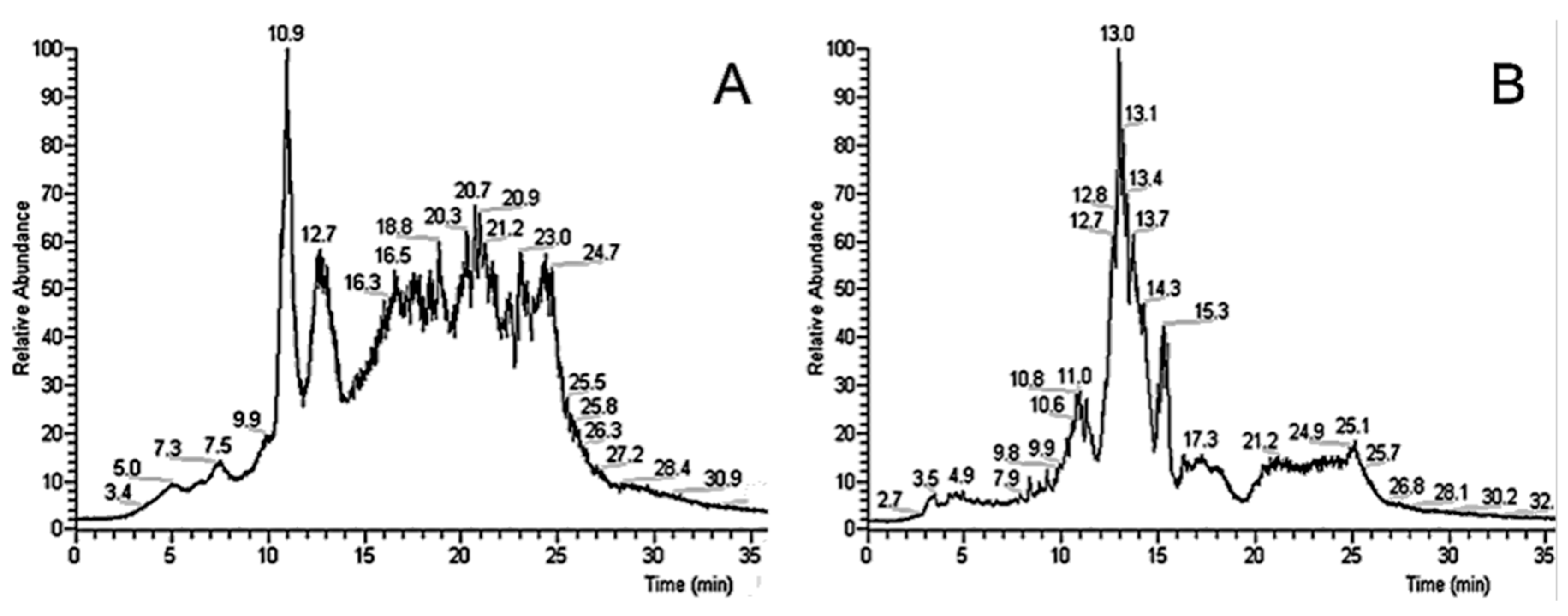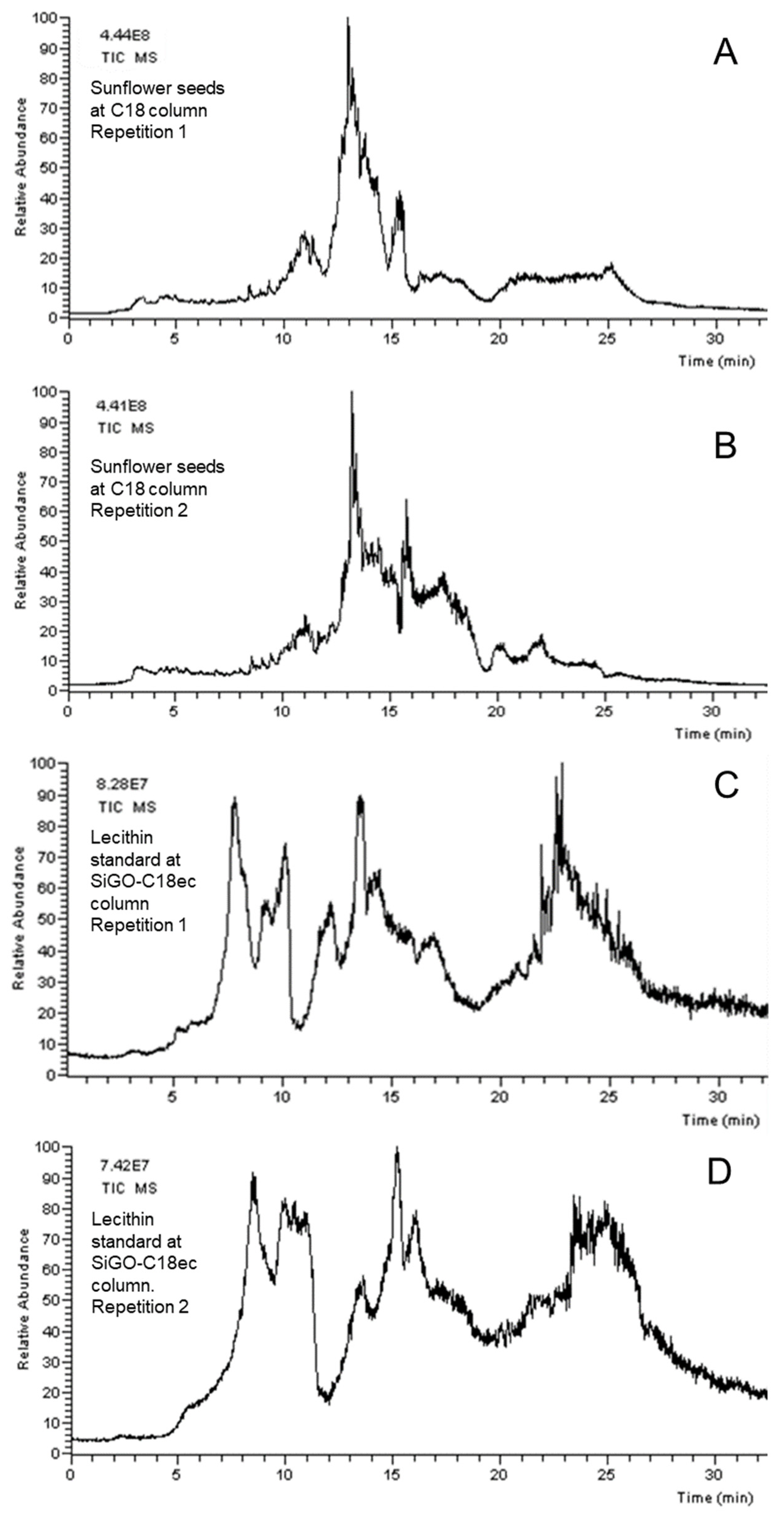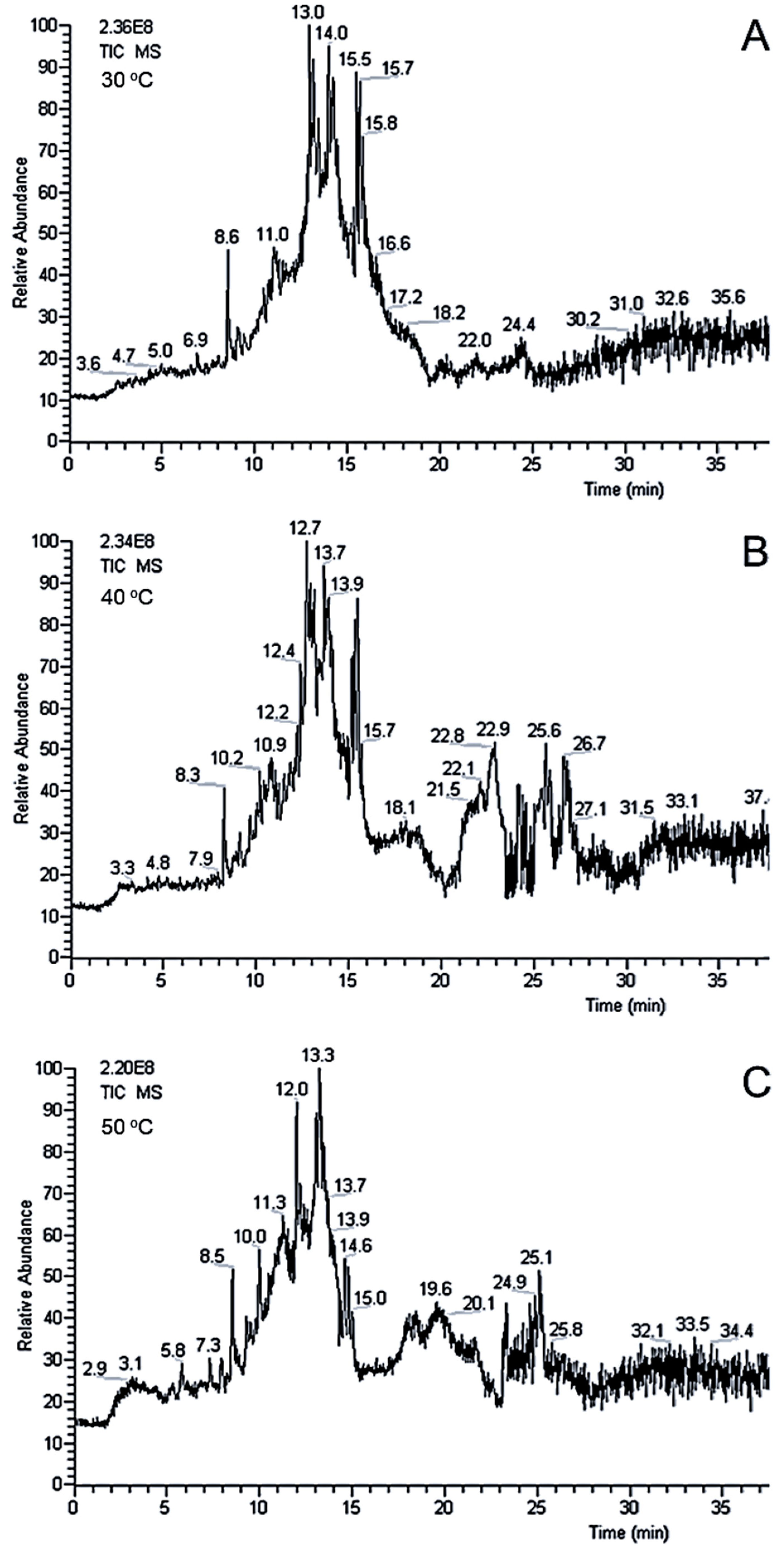Online Extraction Followed by LC–MS/MS Analysis of Lipids in Natural Samples: A Proof-of-Concept Profiling Lecithin in Seeds
Abstract
1. Introduction
2. Experimental
2.1. Chemicals, Samples, and Instrumentation
2.2. OLE System Assemble
2.3. OLE–LC–ESI–MS Analysis
3. Results and Discussion
3.1. Column Selection
3.2. Repeatability
3.3. Temperature Selection
3.4. Lecithin Profile in Seeds Samples
4. Conclusions
Supplementary Materials
Author Contributions
Funding
Institutional Review Board Statement
Informed Consent Statement
Data Availability Statement
Conflicts of Interest
References
- Wei, D.; Li, M.; King, K.W.; Yang, L. Online and Automated Sample Extraction. Bioanalysis 2015, 7, 2227–2233. [Google Scholar] [CrossRef] [PubMed]
- Serra-Mora, P.; Moliner-Martínez, Y.; Molins-Legua, C.; Herráez-Hernández, R.; Verdú-Andrés, J.; Campíns-Falcó, P. Trends in Online Intube Solid Phase Microextraction. Compr. Anal. Chem. 2017, 76, 427–461. [Google Scholar] [CrossRef]
- Fumes, B.H.; Andrade, M.A.; Franco, M.S.; Lanças, F.M. On-Line Approaches for the Determination of Residues and Contaminants in Complex Samples. J. Sep. Sci. 2017, 40, 183–202. [Google Scholar] [CrossRef] [PubMed]
- de Toffoli, A.L.; Fumes, B.H.; Lanças, F.M. Packed In-Tube Solid Phase Microextraction with Graphene Oxide Supported on Aminopropyl Silica: Determination of Target Triazines in Water Samples. J. Environ. Sci. Health. B 2018, 53, 434–440. [Google Scholar] [CrossRef] [PubMed]
- MacIel, E.V.S.; Mejiá-Carmona, K.; Lancas, F.M. Evaluation of Two Fully Automated Setups for Mycotoxin Analysis Based on Online Extraction-Liquid Chromatography-TandemMass Spectrometry. Molecules 2020, 25, 2756. [Google Scholar] [CrossRef] [PubMed]
- Technical Analytical Methods Committee Briefs What Causes Most Errors in Chemical Analysis? Anal. Methods 2013, 5, 2914–2915. [CrossRef] [PubMed]
- Moliner-Martinez, Y.; Ballester-Caudet, A.; Verdú-Andrés, J.; Herráez-Hernández, R.; Molins-Legua, C.; Campíns-Falcó, P. 14—In-Tube Solid-Phase Microextraction. In Solid-Phase Extraction; Poole, C.F., Ed.; Elsevier: Amsterdam, The Netherlands, 2020; pp. 387–427. ISBN 9780128169063. [Google Scholar]
- Kataoka, H. In-Tube Solid-Phase Microextraction: Current Trends and Future Perspectives. J. Chromatogr. A 2021, 1636, 461787. [Google Scholar] [CrossRef]
- Costa Queiroz, M.E.; Donizeti de Souza, I.; Marchioni, C. Current Advances and Applications of In-Tube Solid-Phase Microextraction. TrAC Trends Anal. Chem. 2019, 111, 261–278. [Google Scholar] [CrossRef]
- Gou, Y.; Pawliszyn, J. In-Tube Solid-Phase Microextraction Coupled to Capillary LC for Carbamate Analysis in Water Samples. Anal. Chem. 2000, 72, 2774–2779. [Google Scholar] [CrossRef]
- Ferreira, V.G.; Leme, G.M.; Cavalheiro, A.J.; Funari, C.S. Online Extraction Coupled to Liquid Chromatography Analysis (OLE-LC): Eliminating Traditional Sample Preparation Steps in the Investigation of Solid Complex Matrices. Anal. Chem. 2016, 88, 8421–8427. [Google Scholar] [CrossRef]
- Assirati, J.; Rinaldo, D.; Rabelo, S.C.; da Silva Bolzani, V.; Hilder, E.F.; Funari, C.S. A Green, Simplified, and Efficient Experimental Setup for a High-Throughput Screening of Agri-Food by-Products—From Polar to Nonpolar Metabolites in Sugarcane Solid Residues. J. Chromatogr. A 2020, 1634, 461693. [Google Scholar] [CrossRef] [PubMed]
- Cao, Y.; Liu, W.; Gong, X.; Yu, J.; Tu, P.; Li, J.; Song, Y. Online Pressurized Liquid Extraction Enables Directly Chemical Analysis of Herbal Medicines: A Mini Review. J. Pharm. Biomed. Anal. 2021, 205, 114332. [Google Scholar] [CrossRef]
- Votani, A.; Chisvert, A.; Giokas, D.L. On-Line Extraction Coupled to Liquid Chromatographic Analysis of Hydrophobic Organic Compounds from Complex Solid Samples—Application to the Analysis of UV Filters in Soils and Sediments. J. Chromatogr. A 2020, 1610, 460561. [Google Scholar] [CrossRef]
- Maciel, E.V.S.; Lanças, F.M. A Cartridge-Based Device for Automated Analyses of Solid Matrices by Online Sample Prep–Capillary LC-MS/MS. Anal. Bioanal. Chem. 2022, 414, 2725–2737. [Google Scholar] [CrossRef] [PubMed]
- Xu, X.; Li, T.; Zhang, K.; Cao, Y.; Liu, L.; Zhang, S.; Tu, P.; Song, Y.; Zhao, Y.; Li, J. Direct Flavonoid-Focused Chemical Comparison among Three Epimedium Plants by Online Liquid Extraction-High Performance Liquid Chromatography-Tandem Mass Spectrometry. Molecules 2021, 26, 1520. [Google Scholar] [CrossRef] [PubMed]
- Qian, Z.-M.; Chen, L.; Wu, M.-Q.; Li, D.-Q. Rapid Screening and Characterization of Natural Antioxidants in Polygonum Viviparum by an On-Line System Integrating the Pressurised Liquid Micro-Extraction, HPLC-DAD-QTOF-MS/MS Analysis and Antioxidant Assay. J. Chromatogr. B Anal. Technol. Biomed. Life Sci. 2020, 1137, 121926. [Google Scholar] [CrossRef]
- Wang, F.; Cheng, L.; Cao, Y.; Wei, Q.; Tong, C.; Shi, S. Online Extraction and Enrichment Coupling with High-speed Counter-current Chromatography for Effective and Target Isolation of Antitumor Anthraquinones from Seeds of Cassia Obtusifolia. J. Sep. Sci. 2022, 45, 938–944. [Google Scholar] [CrossRef]
- Bot, F.; Cossuta, D.; O’Mahony, J.A. Inter-Relationships between Composition, Physicochemical Properties and Functionality of Lecithin Ingredients. Trends Food Sci. Technol. 2021, 111, 261–270. [Google Scholar] [CrossRef]
- Deng, L. Current Progress in the Utilization of Soy-Based Emulsifiers in Food Applications—A Review. Foods 2021, 10, 1354. [Google Scholar] [CrossRef]
- Alhajj, M.J.; Montero, N.; Yarce, C.J.; Salamanca, C.H. Lecithins from Vegetable, Land, and Marine Animal Sources and Their Potential Applications for Cosmetic, Food, and Pharmaceutical Sectors. Cosmetics 2020, 7, 87. [Google Scholar] [CrossRef]
- Fernandes, G.D.; Alberici, R.M.; Pereira, G.G.; Cabral, E.C.; Eberlin, M.N.; Barrera-Arellano, D. Direct Characterization of Commercial Lecithins by Easy Ambient Sonic-Spray Ionization Mass Spectrometry. Food Chem. 2012, 135, 1855–1860. [Google Scholar] [CrossRef]
- Alves, E.; Simoes, A.; Domingues, M.R. Fruit Seeds and Their Oils as Promising Sources of Value-Added Lipids from Agro-Industrial Byproducts: Oil Content, Lipid Composition, Lipid Analysis, Biological Activity and Potential Biotechnological Applications. Crit. Rev. Food Sci. Nutr. 2021, 61, 1305–1339. [Google Scholar] [CrossRef]
- Alves, E.; Domingues, M.; Domingues, P. Polar Lipids from Olives and Olive Oil: A Review on Their Identification, Significance and Potential Biotechnological Applications. Foods 2018, 7, 109. [Google Scholar] [CrossRef] [PubMed]
- Yang, Y.; Liang, Y.; Yang, J.; Ye, F.; Zhou, T.; Gongke, L. Advances of Supercritical Fluid Chromatography in Lipid Profiling. J. Pharm. Anal. 2019, 9, 1–8. [Google Scholar] [CrossRef]
- Dogra, R.; Kumar, M.; Kumar, A.; Roverso, M.; Bogialli, S.; Pastore, P.; Mandal, U.K. Derivatization, an Applicable Asset for Conventional HPLC Systems without MS Detection in Food and Miscellaneous Analysis. Crit. Rev. Anal. Chem. 2022, 1–21. [Google Scholar] [CrossRef] [PubMed]
- Cajka, T.; Fiehn, O. Comprehensive Analysis of Lipids in Biological Systems by Liquid Chromatography-Mass Spectrometry. TrAC Trends Anal. Chem. 2014, 61, 192–206. [Google Scholar] [CrossRef] [PubMed]
- York, J.L.; Magnuson, R.H.; Schug, K.A. On-Line Sample Preparation for Multiclass Vitamin, Hormone, and Mycotoxin Determination in Chicken Egg Yolk Using LC-MS/MS. Food Chem. 2020, 326, 126939. [Google Scholar] [CrossRef]
- Siejak, P.; Smułek, W.; Nowak-Karnowska, J.; Dembska, A.; Neunert, G.; Polewski, K. Bird Cherry (Prunus Padus) Fruit Extracts Inhibit Lipid Peroxidation in PC Liposomes: Spectroscopic, HPLC, and GC–MS Studies. Appl. Sci. 2022, 12, 7820. [Google Scholar] [CrossRef]
- Liu, Y.; Wang, Y.; Hao, Z.; Pan, L. HPLC Method for Separation of Cannabidiol Hemp Seed Oil with Skin Lipids and Tandem HRMS Technology for Characterization of a Chemical Marker. Cosmetics 2021, 8, 108. [Google Scholar] [CrossRef]
- Lagutin, K.; Mackenzie, A.; Bloor, S.; Scott, D.; Vyssotski, M. HPLC-MS, GC and NMR Profiling of Bioactive Lipids of Human Milk and Milk of Dairy Animals (Cow, Sheep, Goat, Buffalo, Camel, Red Deer). Separations 2022, 9, 145. [Google Scholar] [CrossRef]
- de Toffoli, A.L.; Lanças, F.M.; de Toffoli, A.L.; Maciel, E.V.S.; Fumes, B.H.; Lanças, F.M. The Role of Graphene-Based Sorbents in Modern Sample Preparation Techniques. J. Sep. Sci. 2018, 41, 288–302. [Google Scholar] [CrossRef] [PubMed]
- Mejía-Carmona, K.; Lanças, F.M. Modified Graphene-Silica as a Sorbent for in-Tube Solid-Phase Microextraction Coupled to Liquid Chromatography-Tandem Mass Spectrometry. Determination of Xanthines in Coffee Beverages. J. Chromatogr. A 2020, 1621, 461089. [Google Scholar] [CrossRef] [PubMed]
- Qu, Q.; Gu, C.; Hu, X. Capillary Coated with Graphene and Graphene Oxide Sheets as Stationary Phase for Capillary Electrochromatography and Capillary Liquid Chromatography. Anal. Chem. 2012, 84, 8880–8890. [Google Scholar] [CrossRef]
- Borsatto, J.V.B.; Maciel, E.V.S.; Lanças, F.M. Investigation of the Applicability of Silica-Graphene Hybrid Materials as Stationary Phases for Capillary Liquid Chromatography. J. Chromatogr. A 2022, 1685, 463618. [Google Scholar] [CrossRef] [PubMed]
- Liu, W.; Song, Q.; Yan, Y.; Liu, Y.; Li, P.; Wang, Y.; Tu, P.; Song, Y.; Li, J. Integrated Approach for Confidence-Enhanced Quantitative Analysis of Herbal Medicines, Cistanche Salsa as a Case. J. Chromatogr. A 2018, 1561, 56–66. [Google Scholar] [CrossRef] [PubMed]
- Liebisch, G.; Drobnik, W.; Lieser, B.; Schmitz, G. High-Throughput Quantification of Lysophosphatidylcholine by Electrospray Ionization Tandem Mass Spectrometry. Clin. Chem. 2002, 48, 2217–2224. [Google Scholar] [CrossRef] [PubMed]





| Time | Water (0.1% FA) % | Methanol (0.1% FA) % | Chloroform % | 2-Propanol % |
|---|---|---|---|---|
| 0 | 100 | 0 | 0 | 0 |
| 10 | 0 | 100 | 0 | 0 |
| 20 | 0 | 10 | 90 | 0 |
| 30 | 0 | 10 | 0 | 90 |
| 35 | 0 | 10 | 0 | 90 |
| Lecithin Standard | Almond | Peanut | Pistachio | Sunflower | |||||
|---|---|---|---|---|---|---|---|---|---|
| tR | m/z (+) | tR | m/z (+) | tR | m/z (+) | tR | m/z (+) | tR | m/z (+) |
| 13.6 | 184 | 13.3 | 184 | 13.3 | 184 | 13.3 | 184 | 13.5 | 184 |
| 339 | 339 | 207 | |||||||
| 575 | 577 | 577 | 575 | 575 | |||||
| 601 | 601 | 603 | 599 | 599 | |||||
| 643 | |||||||||
| 758 | 758 | 760 | 758 | 758 | |||||
| 782 | 784 | 784 | 784 | 784 | |||||
| 15.2 | 184 | 15 | 184 | 14.8 | 184 | ||||
| 306 | 207 | ||||||||
| 365 | |||||||||
| 491 | |||||||||
| 575 | 575 | 575 | |||||||
| 599 | 601 | 599 | |||||||
| 617 | 615 | ||||||||
| 758 | 758 | 758 | |||||||
| 782 | 784 | 782 | |||||||
| 842 | |||||||||
| 877 | |||||||||
| 883 | |||||||||
| 919 | |||||||||
| 935 | |||||||||
| 16 | 184 | 16.1 | 16 | 16.3 | 16.2 | 184 | |||
| 313 | 207 | ||||||||
| 575 | 577 | 577 | 577 | 575 | |||||
| 599 | |||||||||
| 603 | 603 | 603 | 603 | ||||||
| 615 | |||||||||
| 758 | |||||||||
| 782 | |||||||||
| 881 | 881 | 881 | 881 | ||||||
| 882 | |||||||||
| 905 | 905 | 905 | 904 | ||||||
| 907 | |||||||||
Disclaimer/Publisher’s Note: The statements, opinions and data contained in all publications are solely those of the individual author(s) and contributor(s) and not of MDPI and/or the editor(s). MDPI and/or the editor(s) disclaim responsibility for any injury to people or property resulting from any ideas, methods, instructions or products referred to in the content. |
© 2023 by the authors. Licensee MDPI, Basel, Switzerland. This article is an open access article distributed under the terms and conditions of the Creative Commons Attribution (CC BY) license (https://creativecommons.org/licenses/by/4.0/).
Share and Cite
Borsatto, J.V.B.; Maciel, E.V.S.; Cifuentes, A.; Lanças, F.M. Online Extraction Followed by LC–MS/MS Analysis of Lipids in Natural Samples: A Proof-of-Concept Profiling Lecithin in Seeds. Foods 2023, 12, 281. https://doi.org/10.3390/foods12020281
Borsatto JVB, Maciel EVS, Cifuentes A, Lanças FM. Online Extraction Followed by LC–MS/MS Analysis of Lipids in Natural Samples: A Proof-of-Concept Profiling Lecithin in Seeds. Foods. 2023; 12(2):281. https://doi.org/10.3390/foods12020281
Chicago/Turabian StyleBorsatto, João V. B., Edvaldo V. S. Maciel, Alejandro Cifuentes, and Fernando M. Lanças. 2023. "Online Extraction Followed by LC–MS/MS Analysis of Lipids in Natural Samples: A Proof-of-Concept Profiling Lecithin in Seeds" Foods 12, no. 2: 281. https://doi.org/10.3390/foods12020281
APA StyleBorsatto, J. V. B., Maciel, E. V. S., Cifuentes, A., & Lanças, F. M. (2023). Online Extraction Followed by LC–MS/MS Analysis of Lipids in Natural Samples: A Proof-of-Concept Profiling Lecithin in Seeds. Foods, 12(2), 281. https://doi.org/10.3390/foods12020281








